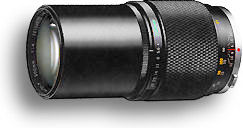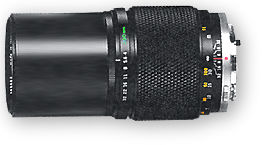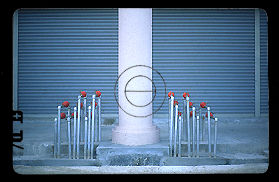Prior to the availability of 180mm fixed focal length and zoom lenses, 200mm focal length is the next lens after the 135mm - perhaps that is one of the reason why the Zuiko 200mm f/4.0 was so popular during those days. Naturally, the modest entry price of the lens, its high optical performance with excellent resolution and remarkably low distortion level also contributed to its popularity among the many OM users.
 |
Zuiko 200mm F4.0 |
Handling is very good and it is an extremely well made lens, light but rigid while maintaining excellent overall balance.
The telephoto ratio of this
lens is 0.81 and although its length is held to 127mm, curvature of field and
spherical aberrations are contained to absolute minimal level. Another
attractive feature of this lens is that it has the closest focusing distance
of 2.5 meters and with a minimal aperture of f/32, it supplements well for
those whose works always demand extended depth of field.
 |
This lens has a filter size of 55mm, weighs 515g and with a body length of 127mm. It is not the smallest nor the most compact in its class. |
Strangely, the older version E-Zuiko Auto-T 200mm f/4.0 is slight lighter than the newer Zuiko 200mm f/4.0. But if compactness and lightweight that is your priority, Olympus did produced a very compact 200mm Zuiko lens during the early '70.
The F-Zuiko AUTO-T 200mm f/5.0 weighs merely 380g, with a optical composition of 6 elements in 5 groups, a body length (before extension) of only 105mm long. Further, it stops down to f/32 and closest focus distance achievable similarly with the f/4.0 lens at 2.5m (8.2 ft). An used 200mm f/5.0 may fetch at only USD110-90 as compared with the f/4.0's USD120-200. Naturally, both lenses are more realistic when comparing with the fast speed 180mm f/2.8 which has a used price ranges from USD350-650 !
These prices may get a lot of alternatives in zoom lenses of almost equivalent maximum aperture of f/4.0 or even f3.5. Some third party zoom lenses may even offer more features and better specifications than these fixed focal length lenses by Olympus. Thus, unless the lens comes with attractive pricing and resonably well kept condition, you can ignore the shop or whoever offers you such a deal and opt for other better and more logical options.
 |
<<<<<<<-------- A visual comparison between a Zuiko 200mm f/4.0, 180mm f/2.8 and a 135mm f/2.8 lens. |
Generally, the price should be half that of the Zuiko 180mm f2.8 and the weight, size of this lens is very much compact in size and lighter making them a perfect companion for long distance traveling If price is your prime consideration. you can always offset the slower lens speed by selecting a faster film to compensate for the lost lens speed from f/2.8 to f/4.0. The f/4.0 lens uses 55mm filter accessories while the 200mm f5.0 shares most 49mm filters with other Zuiko optics. However, if you need more flexible depth of field control or often work with low available light photography, do consider stepping up to the f/4.0 or even the f2.8 version at 180mm focal length.
*** By the way, does anyone has a 200mm Zuiko f5.0 ? I do need a picture here to illustrate others, appropriate credit will be given.
| Specifications Len type: Zuiko 200mm f/4.0 Focal length: 200mm Lens construction: 4 groups, 5 elements Angles of view: Diagonal: 12‘ * More info on "Picture Angle". Distance scale: (m) 2.5m (8.2ft) to infinity (OO) Focusing: Helicoid Minimum and Maximum aperture: f/32-f/4.0 Tele-Converter: 2X A Diaphragm: Automatic Lens Hood: Built-in Filter size: 55mm Length: 127mm Maximum diameter: 67mm Weight: 515g (18.2 oz) Recommended Focusing Screens: 1:1*, 1:2*, 1:3*, 1:4n*, 1:6#, 1:10*, 1:13*, 1:14* * Compatible. Focusing and exposure accuracy remains # Can be used, they provide accurate focusing but exposure error may occur in manual mode for OM1 and OM2 series models. |
Specifications Len type: F-Zuiko AUTO-T 200mm f/5.0 Focal length: 200mm Lens construction: 5 groups, 6 elements Angles of view: Diagonal: 12‘ Distance scale: (m) 2.5m (8.2ft) to infinity (OO) Focusing: Helicoid Minimum and Maximum aperture: f/32-f/5.0 Diaphragm: Automatic Filter size: 49mm Lens Hood: Built-in Length: 105mm Maximum diameter: 62mm Weight: 380g (13.4oz) Recommended Focusing Screens: 1:1*, 1:2*, 1:3*, 1:4n*, 1:6#, 1:10*, 1:13*, 1:14* * Compatible. Focusing and exposure accuracy remains # Can be used, they provide accurate focusing but exposure error may occur in manual mode for OM1 and OM2 series models. |
 |
 |
|
Reserved Sample image 1 |
Reserved Sample image 2 |
Reserved Sample image 3 |
Reserved Sample image 4 |
Reserved Sample image 5 |
N O T E: As no photographer in the world would possess ALL the lenses within a single trade name. You are always encouraged to replace these reserved slot for sample images above shooting with a lens type detailed above - just mail in your creative visual, a little caption relative to the background information will help a lot to let other understand how you prepared the shot. Please mention IF you require a complimentary link and where should it be pointed at. Naturally, I DO NOT like to disappoint anyone, but in order to maintain my self-set standard in the PIM website - I would prefer to have high quality input rather than in quantity, if your image is NOT selected for broadcasting in this site, give it a try the next time but I do promise every image will be view and consider carefully. I do appreciate your consideration in this matter.
OFF-topic Supplements
The depth of field of the 180-200mm is comparatively limited at any aperture as compared with lenses having shorter angle-of-views. At maximum aperture depth of field is extremely shallow and may require precise focusing.
The range of sharp focus increases, of course, as camera-to-subject distance increases and as you select smaller apertures. With lenses of these focal lengths, perspective often works best when the foreground and background are as sharp as possible. Maximize the benefit and the unique optical characteristic of telephoto lenses such as compression effect by using small apertures whenever possible to increase depth of field. This works best if there are subjects of similar patterns. |
Pipes... (43k Jpeg File) Copyright ©-free Images collection, 2000, leofoo Malaysian Internet Resources
On the other hand, it is easy to render out of focus unwanted background and foreground images to emphasize the main subject or to play down distracting elements at the background inside a picture. The larger the aperture, the more effective this technique. The fast speed Zuiko lenses at 180mm focal length provide the best solution to portraiture with such visual effect, focal length of 200mm with the maximum aperture limiting to f/4.0 may not be the best option but still provides a fairly good effect for a reasonably blur effect in front and behind the subject in full length portraits. But other than full length portrait, the f/4.0 and even the f/5.0 is more than good enough for a head and shoulder or half length portraiture. Another good use of these lenses is its ability to isolate a small portion and magnify on how we visualize a full vision with human eyes - this is especially useful for scenic shots where you can train your eyes to isolate an interesting portion of the scene.
| Previous | the two Zuiko 180mm lenses
|
Back
|
Index Page of OM Zuiko Lenses
|
Back
| to Main
Index Page of OM1(n) & OM2(n)
Series SLRs
